HONDA PASSPORT 2001 2.G Owners Manual
Manufacturer: HONDA, Model Year: 2001, Model line: PASSPORT, Model: HONDA PASSPORT 2001 2.GPages: 317, PDF Size: 4.85 MB
Page 291 of 317
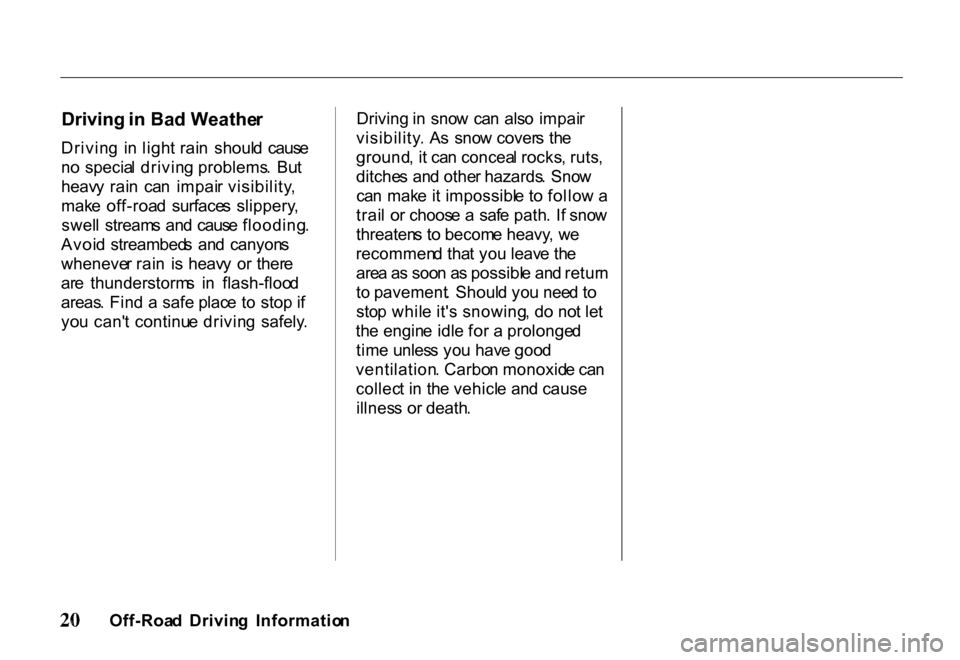
Driving
in Ba d Weathe r
Drivin g i n ligh t rai n shoul d caus e
n o specia l drivin g problems . Bu t
heav y rai n ca n impai r visibility ,
mak e off-roa d surface s slippery ,
swel l stream s an d caus e flooding .
Avoi d streambed s an d canyon s
wheneve r rai n i s heav y o r ther e
ar e thunderstorm s i n flash-floo d
areas . Fin d a safe plac e t o stop if
yo u can' t continu e drivin g safely . Driving
in sno w ca n als o impai r
visibility . A s sno w cover s th e
ground , i t ca n concea l rocks , ruts ,
ditche s an d othe r hazards . Sno w
ca n mak e i t impossibl e t o follo w a
trai l o r choos e a saf e path . I f sno w
threaten s t o becom e heavy , w e
recommen d tha t yo u leav e th e
are a a s soo n a s possibl e an d retur n
t o pavement . Shoul d yo u nee d t o
sto p whil e it' s snowing , d o no t le t
th e engin e idl e fo r a prolonge d
tim e unles s yo u hav e goo d
ventilation . Carbo n monoxid e ca n
collec t i n th e vehicl e an d cause
illnes s or death .
Off-Roa d Drivin g Informatio n
Page 292 of 317
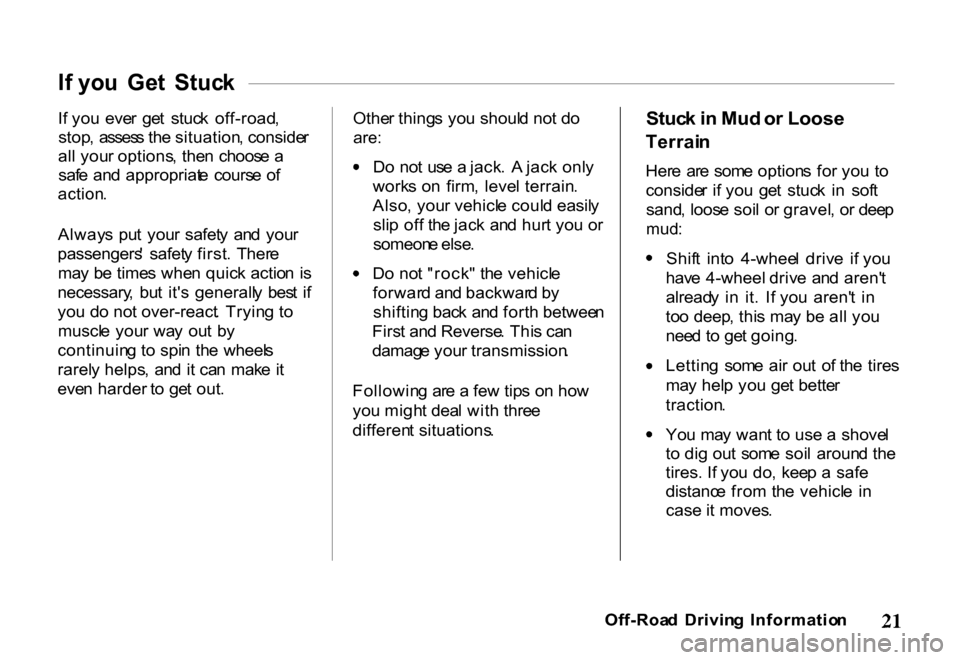
I
f yo u Ge t Stuc k
I f yo u eve r ge t stuc k off-road ,
stop , asses s th e situation , conside r
al l you r options , the n choos e a
saf e an d appropriat e cours e o f
action .
Alway s pu t you r safet y an d you r
passengers ' safet y first . Ther e
ma y b e time s whe n quic k actio n is
necessary , bu t it' s generall y bes t i f
yo u d o no t over-react . Tryin g t o
muscl e you r wa y ou t b y
continuin g t o spi n th e wheel s
rarel y helps , an d it ca n mak e it
eve n harder to ge t out . Othe
r thing s yo u shoul d no t d o
are:
D
o no t us e a jack . A jac k onl y
work s o n firm , leve l terrain .
Also , you r vehicl e coul d easil y
sli p of f th e jac k an d hur t yo u o r
someon e else . D
o no t "rock " th e vehicl e
forwar d an d backwar d b y
shiftin g bac k an d fort h betwee n
Firs t an d Reverse . Thi s ca n
damag e you r transmission .
Followin g ar e a fe w tip s o n ho w
yo u migh t dea l wit h thre e
differen t situations . Stuc
k in Mud or Loose
Terrai n
Her e ar e som e option s fo r yo u t o
conside r i f yo u ge t stuc k i n sof t
sand , loos e soi l o r gravel , o r dee p
mud :
Shif
t int o 4-whee l driv e i f yo u
hav e 4-wheel drive an d aren' t
alread y i n it . I f yo u aren' t i n
to o deep , thi s ma y b e al l yo u
nee d t o ge t going . Lettin
g som e ai r ou t o f th e tire s
ma y hel p yo u ge t bette r
traction .
Yo
u ma y wan t t o use a shove l
t o di g ou t som e soi l aroun d th e
tires. If yo u do , kee p a safe
distanc e fro m th e vehicl e i n
case it moves .
Off-Roa d Drivin g Informatio n
Page 293 of 317
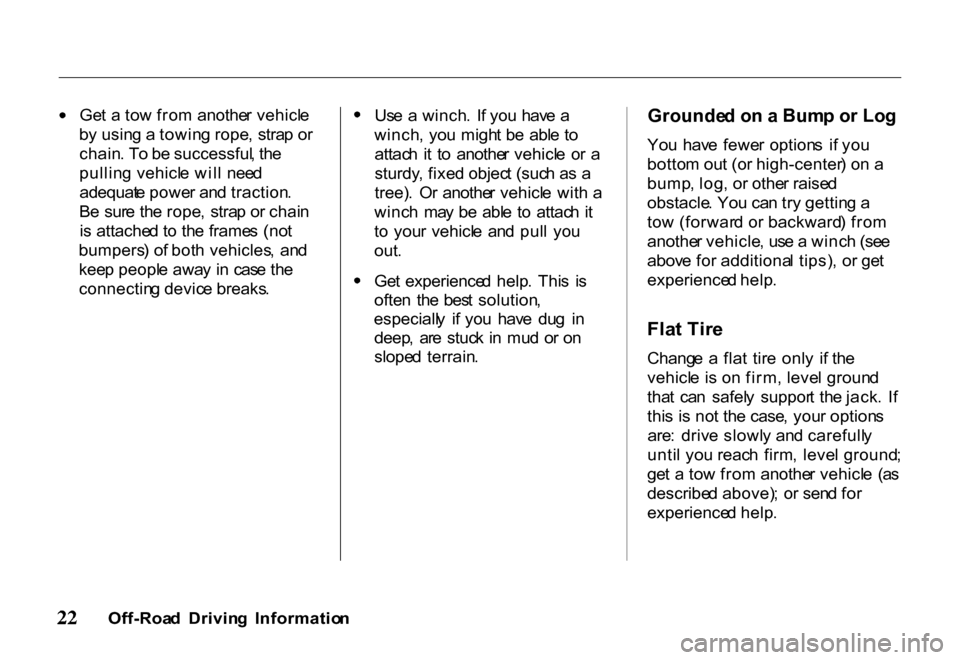
Ge
t a to w fro m anothe r vehicl e
b y usin g a towin g rope , stra p o r
chain . T o b e successful , th e
pullin g vehicl e wil l nee d
adequat e powe r an d traction .
B e sur e th e rope , stra p o r chai n
i s attache d t o th e frame s (no t
bumpers ) o f bot h vehicles , an d
kee p peopl e awa y i n cas e th e
connectin g devic e breaks . Us
e a winch . I f yo u hav e a
winch , yo u migh t b e abl e t o
attac h i t t o anothe r vehicl e o r a
sturdy , fixe d objec t (suc h a s a
tree) . O r anothe r vehicl e wit h a
winc h ma y b e abl e t o attac h it
t o you r vehicl e an d pul l yo u
out .
Ge t experience d help . Thi s i s
ofte n th e bes t solution ,
especiall y i f yo u hav e du g i n
deep , ar e stuc k i n mu d o r o n
slope d terrain .
Grounde
d o n a Bum p o r Lo g
Yo u hav e fewe r option s i f yo u
botto m ou t (o r high-center ) o n a
bump , log , o r othe r raise d
obstacle . Yo u ca n tr y gettin g a
to w (forwar d o r backward ) fro m
anothe r vehicle , us e a winc h (se e
abov e fo r additiona l tips) , o r ge t
experience d help .
Fla t Tir e
Chang e a fla t tir e onl y i f th e
vehicl e i s o n firm , leve l groun d
tha t ca n safel y suppor t th e jack . I f
thi s i s no t th e case , you r option s
are : driv e slowl y an d carefull y
unti l yo u reac h firm , leve l ground ;
ge t a to w fro m anothe r vehicl e (a s
describe d above) ; o r sen d fo r
experience d help .
Off-Roa d Drivin g Informatio n
Page 294 of 317
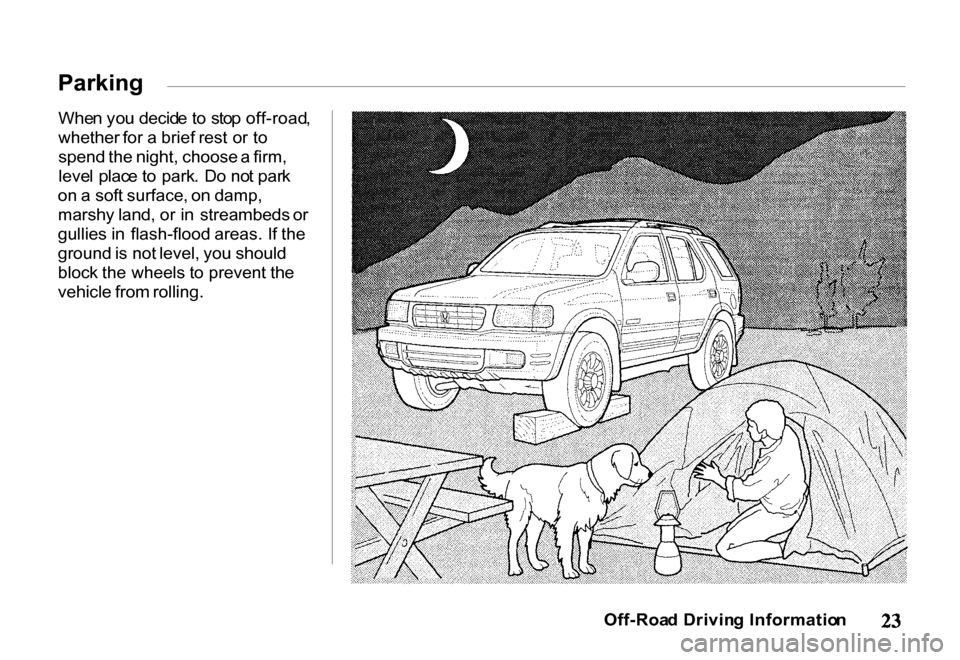
Whe
n yo u decid e t o sto p off-road ,
whether for a brief rest or to
spend the night, choose a firm,
leve l plac e t o park . D o no t par k
on a soft surface, on damp,
marshy land, or in streambeds or
gullies in flash-flood areas. If the
ground is not level, you should
block the wheels to prevent the
vehicle from rolling.
Off-Road Drivin g Informatio n
Parking
Page 295 of 317
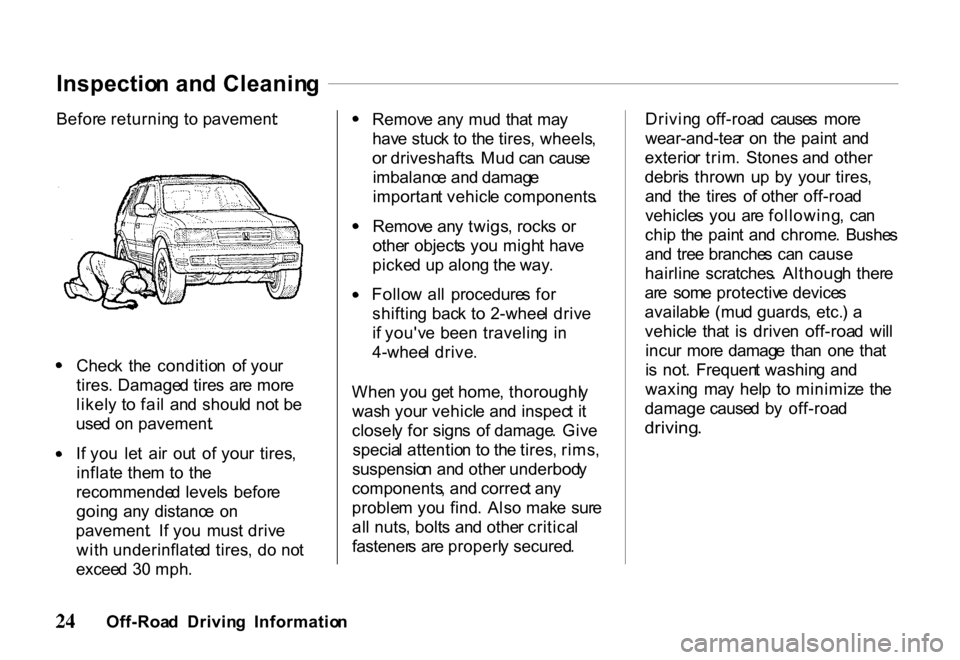
Befor
e returnin g t o pavement :
Chec k th e conditio n o f you r
tires . Damage d tire s ar e mor e
likel y t o fai l an d shoul d no t b e
use d o n pavement .
I f yo u le t ai r ou t o f you r tires ,
inflat e the m to th e
recommende d level s befor e
goin g an y distanc e o n
pavement . I f yo u must drive
wit h underinflate d tires , d o no t
excee d 3 0 mph . Remov
e an y mu d tha t ma y
hav e stuc k t o th e tires , wheels ,
o r driveshafts . Mu d ca n caus e
imbalanc e an d damag e
importan t vehicl e components .
Remov e an y twigs , rock s o r
othe r object s yo u migh t hav e
picke d u p alon g th e way . Follo
w al l procedure s fo r
shiftin g bac k t o 2-whee l driv e
i f you'v e been travelin g i n
4-whee l drive .
Whe n yo u ge t home , thoroughl y
was h you r vehicl e an d inspec t i t
closel y fo r sign s o f damage . Giv e
specia l attentio n t o th e tires , rims ,
suspensio n an d othe r underbod y
components , an d correc t an y
proble m yo u find . Als o mak e sur e
al l nuts , bolt s an d othe r critica l
fastener s ar e properl y secured . Drivin
g off-roa d cause s mor e
wear-and-tea r o n th e pain t an d
exterio r trim . Stones and other
debri s throw n u p b y you r tires ,
an d th e tire s o f othe r off-roa d
vehicle s yo u ar e following , ca n
chi p th e pain t an d chrome . Bushe s
an d tre e branche s ca n cause
hairlin e scratches . Althoug h ther e
ar e som e protectiv e device s
availabl e (mu d guards , etc. ) a
vehicl e tha t i s drive n off-roa d will
incu r mor e damag e tha n on e tha t
i s not . Frequen t washin g an d
waxin g ma y hel p t o minimiz e th e
damage caused b y off-roa d
driving .
Off-Roa d Drivin g Informatio n
Inspectio
n an d Cleanin g
Page 296 of 317
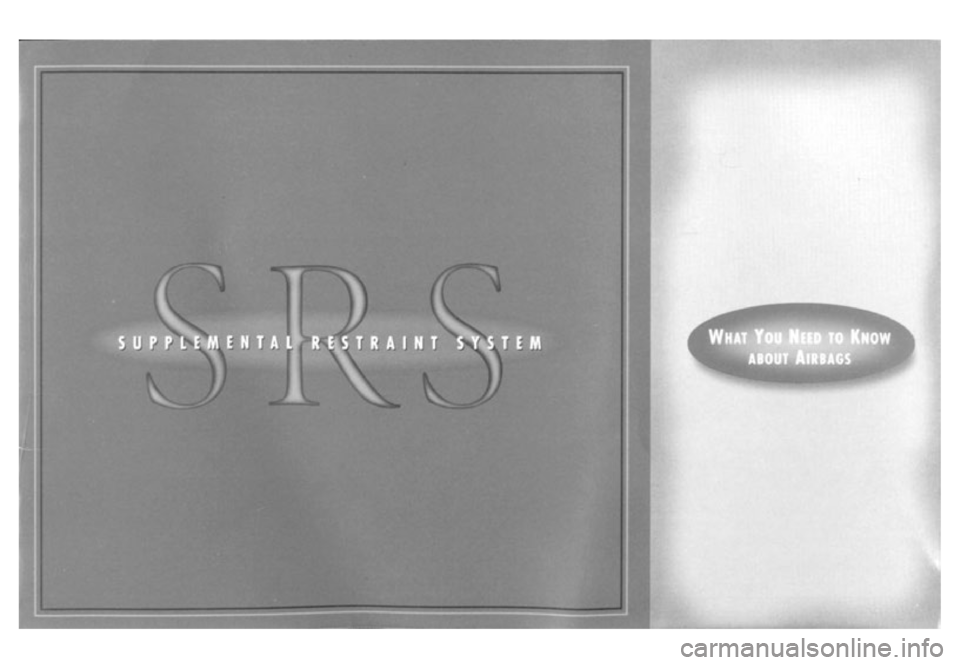
Page 297 of 317

THI
S BROCHUR E WA S PREPARE D T O
ANSWE R YOU R QUESTION S ABOU T
FRONTA L AIRBAGS . PLEAS E TAK E A
FE W MOMENT S T O REA D IT , BECAUS E
W E BELIEV E THA T TH E MOR E YO U
KNO W ABOU T HO W YOU R AIRBAG S
WORK , TH E SAFE R YO U AN D YOU R
PASSENGER S WIL L BE .
Page 298 of 317
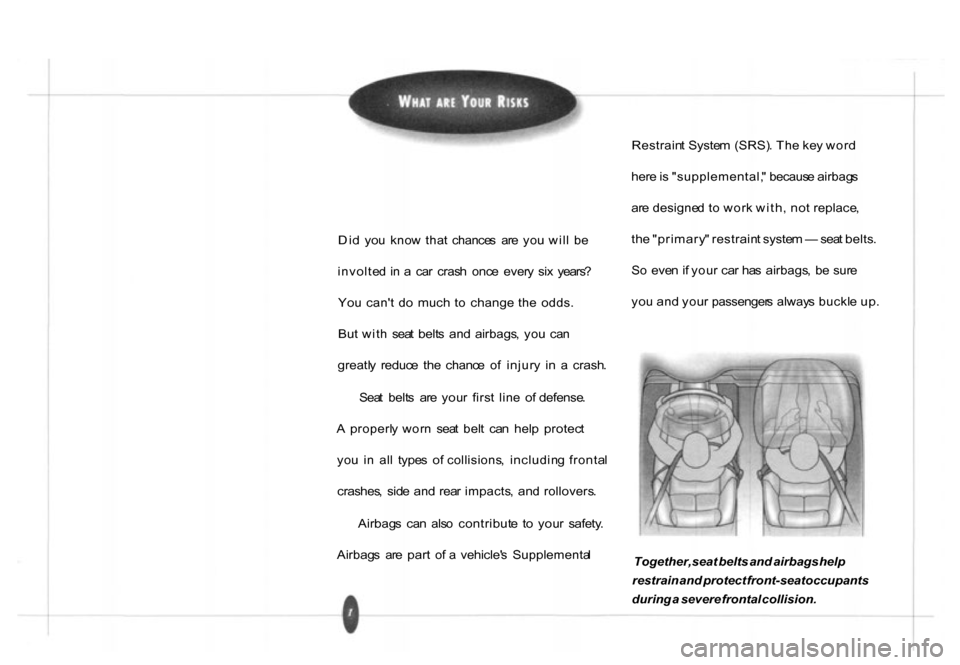
Restrain
t Syste m (SRS) . Th e ke y wor d
her e is "supplemental, " becaus e airbag s
ar e designe d t o wor k with , no t replace ,
th e "primary " restrain t syste m — sea t belts .
S o eve n if you r ca r ha s airbags , b e sur e
yo u an d you r passenger s alway s buckl e up .
Together, seat belts and airbags help
restrain and protect front-seat occupants
during a severe frontal collision.
Di
d yo u kno w tha t chance s ar e yo u wil l b e
involte d in a ca r cras h onc e ever y si x years ?
You can't do much to change the odds.
Bu t wit h sea t belt s an d airbags , yo u ca n
greatl y reduc e th e chanc e o f injur y i n a crash .
Sea t belt s ar e you r firs t lin e o f defense .
A properl y wor n sea t bel t ca n hel p protec t
yo u i n al l type s o f collisions , includin g fronta l
crashes , sid e an d rea r impacts , an d rollovers .
Airbag s ca n als o contribut e t o you r safety .
Airbag s ar e par t o f a vehicle' s Supplementa l
Page 299 of 317
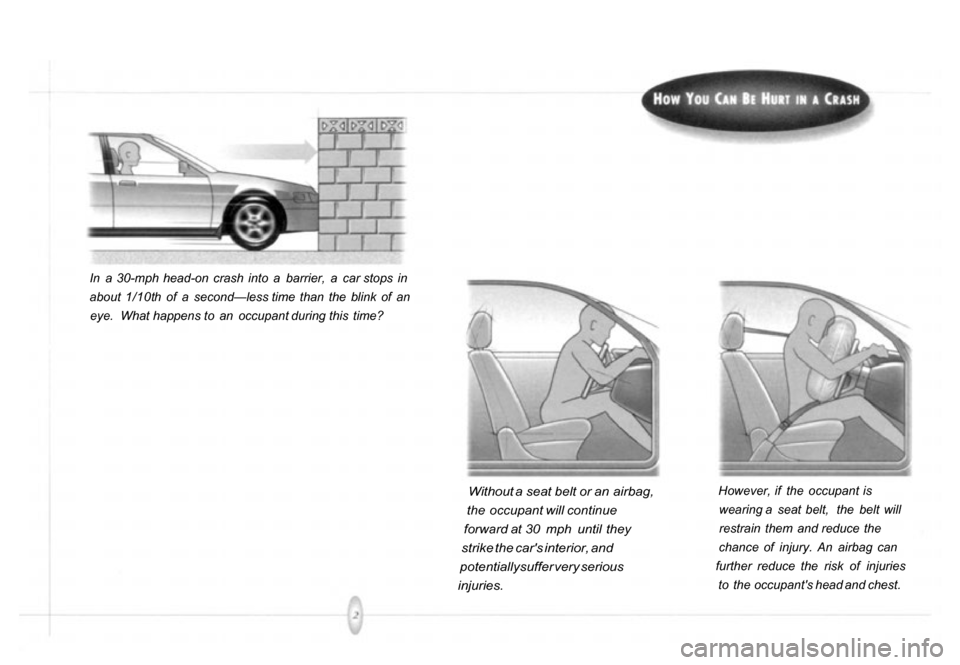
In
a 30-mph head-on crash into a barrier, a car stops in
about 1/10t h o f a second—less time than the blink of a n
eye. What happens to an occupant during this time?
However, if the occupant is
wearing a seat belt, the belt will
restrain them and reduce the
chance of injury. An airbag can
further reduce the risk of injuries
to the occupant's head and chest.
Without
a seat belt or an airbag,
the occupant will continue
forward at 30 mph until they
strike the car's interior, and
potentially suffer very serious
injuries.
Page 300 of 317
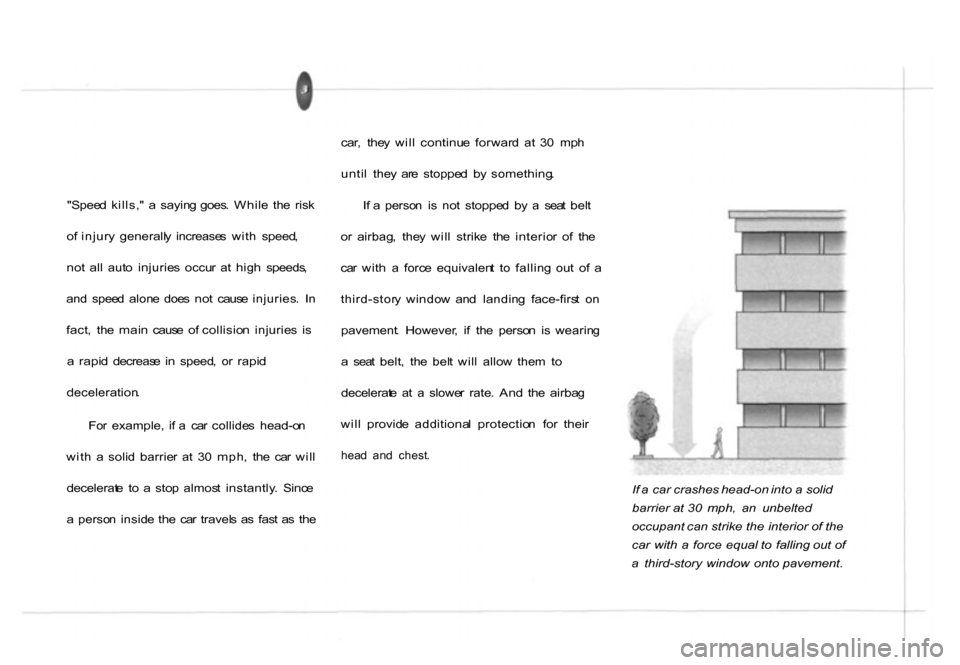
"Spee
d kills, " a sayin g goes . Whil e th e ris k
o f injur y generall y increase s wit h speed ,
no t al l aut o injurie s occu r a t hig h speeds ,
an d spee d alon e doe s no t caus e injuries . I n
fact , th e mai n caus e o f collisio n injurie s i s
a rapi d decreas e i n speed , o r rapi d
deceleration .
Fo r example, if a ca r collide s head-o n
wit h a soli d barrie r a t 3 0 mph , th e ca r wil l
decelerat e t o a sto p almos t instantly . Sinc e
a perso n insid e th e ca r travel s a s fas t a s th e car
, the y wil l continu e forwar d at 30 mp h
unti l the y ar e stoppe d b y something .
I f a perso n i s no t stoppe d b y a sea t bel t
o r airbag , the y wil l strik e th e interio r o f th e
ca r wit h a forc e equivalen t t o fallin g ou t o f a
third-stor y windo w an d landin g face-firs t o n
pavement . However , i f th e perso n i s wearin g
a sea t belt , th e bel t wil l allo w the m to
decelerat e a t a slowe r rate . An d th e airba g
wil l provid e additiona l protectio n for thei r
hea d an d chest .
If a car crashes head-on into a solid
barrier at 30 mph, an unbelted
occupant can strike the interior of the
car with a force equal to falling out of
a third-story window onto pavement.